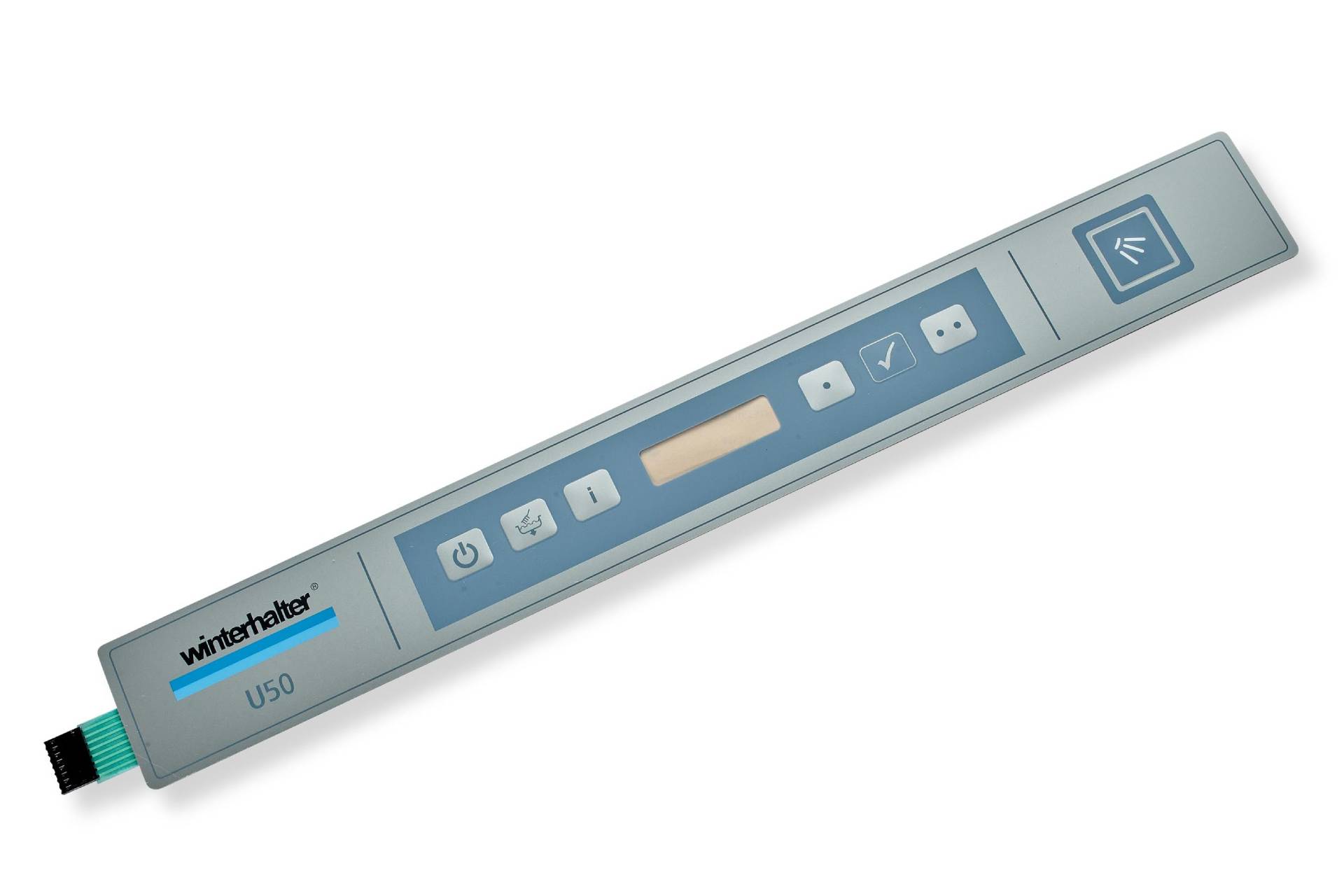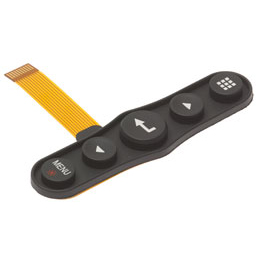Understanding the science of key response in Rubber Keypads
Wiki Article
Discovering the Manufacturing Process Behind Rubber Keypads and Their Value in Modern Gadgets
Rubber keypads are pivotal in the capability of modern tools. Their production procedure includes mindful option of materials and precise techniques. Keypads are designed to improve user interaction while guaranteeing resilience and dependability. Understanding how these parts are made discloses their importance across various applications. What aspects add to their performance, and how do these components influence individual experience? The answers may reshape understandings of this everyday modern technology.Summary of Rubber Keypads and Their Applications

Rubber keypads are functional parts commonly used in various electronic devices, ranging from customer electronic devices to industrial tools. Their layout permits a responsive feedback, making them an ideal option for applications requiring user interaction. Commonly discovered in items such as remotes, calculators, and clinical tools, rubber keypads assist in ease of usage and access.
In industrial setups, they offer critical features in machinery and control panels, where toughness and resistance to ecological variables are necessary. The non-slip surface boosts grasp, promoting integrity sought after problems. Additionally, their light-weight nature and personalized shapes allow suppliers to produce tailored options that fit particular requirements. With advancements in technology, rubber keypads remain to advance, integrating functions like backlighting and boosted sensitivity. On the whole, their adaptability and practical benefits contribute significantly to the performance of numerous tools throughout numerous sectors.
Products Utilized in Rubber Keypad Manufacturing
Keypad making counts on a selection of products that improve both performance and toughness. The key product made use of in the manufacturing of rubber keypads is silicone rubber, understood for its outstanding resilience and flexibility. This material allows keypads to endure repeated pressing without shedding shape or performance. In addition, thermoplastic elastomers (TPE) are typically made use of because of their simplicity of molding and capacity to offer a soft-touch feeling.Tinting agents, such as pigments, are incorporated to guarantee vivid, lasting hues that improve aesthetic charm. Ingredients like anti-UV agents and flame resistants may be mixed right into the rubber to boost weather resistance and safety conformity. The choice of materials straight affects the keypad's tactile response, long life, and overall efficiency in different devices. Ultimately, the cautious choice of these elements is vital for the manufacturing of top quality rubber keypads that satisfy consumer and sector demands.
The Style Process of Rubber Keypads
When creating rubber keypads, the style procedure plays a necessary duty in figuring out functionality and user experience. Designers start by defining the keypad's intended usage, taking into consideration elements such as the device it will come with and the target individual group. This initial phase includes sketching layouts that focus on ergonomic aspects, ensuring the keys are easily obtainable and suitably spaced.Next off, designers focus on the responsive feedback wanted from the keypads, which influences the choice of products and essential forms. Prototyping is important in this stage, permitting designers to evaluate numerous layouts for convenience and responsiveness.

Production Techniques for Rubber Keypads
The manufacturing procedure for rubber keypads entails a series of specific techniques that assure top quality and performance. Fluid silicone rubber (LSR) is usually used due to its sturdiness and flexibility. The process starts with mixing the raw materials, including silicone, colorants, and healing agents. This mix is then injected right into mold and mildews developed to form the keypads precisely.
Adhering to shot, the shaped keypads undertake treating, a home heating process that solidifies the product (Rubber Keypads). This is generally performed in a press, ensuring the keypads accomplish the desired firmness and resilience
Quality Assurance Procedures in Production
To assure that rubber keypads satisfy high standards of top quality and capability, extensive quality assurance steps are carried out throughout the manufacturing procedure. These procedures begin with basic material examination, making certain that just the highest-grade elastomers are utilized. Throughout the manufacturing stage, operators perform routine checks to keep an eye on criteria such as temperature, pressure, and mixing times, important for accomplishing consistent product top quality.Post-production, each set of keypads goes through detailed screening, consisting of tactile response assessments and resilience tests to evaluate efficiency under various problems. Aesthetic inspections are additionally performed to determine any kind of problems, such as bubbles or disparities in structure. Furthermore, compliance with sector criteria is verified, making sure that the keypads meet safety and capability benchmarks.
The Duty of Technology in Keypad Growth
Innovation plays a vital duty in the advancement of rubber keypads by making it possible for advanced manufacturing strategies that boost precision and effectiveness. description In addition, innovative product choice permits boosted longevity and responsiveness in keypad efficiency. These advancements not just enhance production however additionally boost the total high quality of the end product.Advanced Manufacturing Techniques
Advancements in manufacturing strategies reinvent the manufacturing of rubber keypads, enhancing both effectiveness and accuracy. Technologies such as shot molding and 3D printing have changed traditional procedures, enabling producers to develop intricate designs with decreased waste and check my site improved turn-around times. Automation plays a crucial duty in this advancement, streamlining setting up lines and minimizing human error. Additionally, computer-aided style (CAD) software program enables elaborate modification, making sure that keypads meet particular individual requirements. Quality assurance procedures have actually likewise progressed, incorporating real-time surveillance systems that detect defects early in the manufacturing cycle. These advancements not only improve the durability and functionality of rubber keypads however additionally sustain the growing demand for tailored remedies in various sectors, from consumer electronics to automobile applications.Ingenious Product Option
The evolution of manufacturing techniques has actually led the way for ingenious material choice in rubber keypad advancement. Developments in polymer scientific research have actually presented products that improve resilience, flexibility, and responsive feedback. Producers currently use thermoplastic elastomers (TPE) and silicone compounds, which supply exceptional resistance to use and environmental variables. These products enable the development of keypads that can sustain prolonged usage while maintaining visual allure. Furthermore, the combination of finishings and additives boosts functionality, such as enhancing hold and reducing rubbing. The choice of materials is crucial, as it straight influences the performance and long life of keypads in various devices, from consumer electronic devices to commercial devices. This innovative technique continues to form the future of keypad style and use.The Influence of Rubber Keypads on User Experience
Rubber keypads substantially affect customer experience via their improved responsive action, which permits even more exact interaction. Furthermore, their durability and durability add to constant efficiency gradually, lowering the demand for constant replacements. This mix of attributes makes rubber keypads a preferred selection in numerous applications, ultimately impacting user complete satisfaction.Boosted Tactile Reaction
Enhancing tactile feedback considerably influences customer experience, specifically in devices that depend on keypads for interaction. Rubber keypads provide a special combination of soft qualities and strength, enabling individuals to really feel unique comments with each press. This comments enhances a feeling of control and precision, important in applications varying from smart devices to industrial devices. Individuals typically report greater contentment and performance when engaging with tools that include properly designed rubber keypads, as they facilitate quicker and extra exact input. In addition, the ergonomic style of these keypads can minimize finger exhaustion, advertising longer use durations without discomfort. Generally, the enhanced responsive response provided by rubber keypads substantially adds to an extra instinctive and pleasurable user discover this experience in modern technology.Longevity and Longevity
A key aspect of customer experience with rubber keypads depends on their longevity and longevity. These keypads are made to hold up against comprehensive usage, withstanding wear and tear that typically affects other products. The robust nature of rubber guarantees that keypads maintain their capability and appearance gradually, which is crucial for tools regularly utilized in different settings. Customers gain from the reliability of rubber keypads, as they can endure exposure to temperature, wetness, and dust variations without weakening. This resilience not only boosts individual fulfillment but also decreases the demand for frequent substitutes, inevitably contributing to cost-effectiveness for makers. Basically, the longevity of rubber keypads greatly influences the total performance and customer experience in modern tools.Regularly Asked Inquiries
How Much Time Do Rubber Keypads Generally Last in Devices?
Rubber keypads commonly last in between 5 to one decade, relying on use, ecological aspects, and top quality of materials made use of (Rubber Keypads). Normal deterioration can shorten their life-span, affecting functionality and individual experience with timeCan Rubber Keypads Be Custom-made for Certain Applications?
Rubber keypads can undoubtedly be personalized for particular applications, permitting modifications in size, shape, appearance, and color. This versatility makes it possible for suppliers to develop tailored solutions that meet varied customer requirements and improve performance in different devices.Are Rubber Keypads Environmentally Friendly?
Rubber keypads are commonly not thought about environmentally pleasant as a result of their petroleum-based products. Nevertheless, improvements in sustainable production practices and the advancement of bio-based alternatives are slowly improving their ecological influence in different applications.What Prevail Concerns Encountered During Rubber Keypad Manufacturing?
Common concerns encountered during rubber keypad manufacturing include irregular material quality, mold and mildew problems, improper treating times, adhesion failures, and obstacles in achieving exact tactile feedback. These troubles can bring about lowered item performance and consumer frustration.Just How Do Rubber Keypads Contrast to Various Other Sorts Of Key Switches Over?
Rubber keypads provide a softer feeling and quieter operation compared to mechanical buttons, which give responsive feedback. Rubber keypads might put on out faster and lack the precision that some users prefer in high-performance applications.The key material used in the production of rubber keypads is silicone rubber, understood for its excellent strength and adaptability. When creating rubber keypads, the layout procedure plays a necessary function in establishing capability and customer experience. Rubber keypads significantly affect individual experience via their improved tactile response, which allows for more precise communication. Customers often report better satisfaction and effectiveness when connecting with tools that include properly designed rubber keypads, as they promote quicker and extra exact input. A key aspect of user experience with rubber keypads exists in their sturdiness and longevity.
Report this wiki page